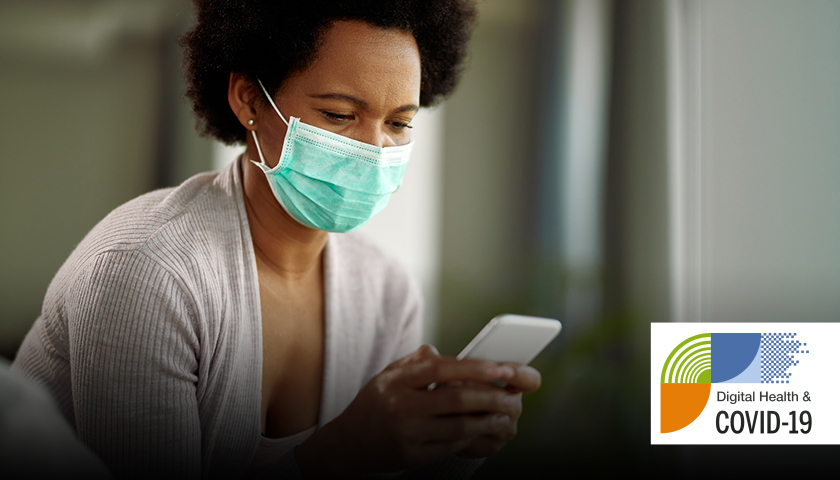3 ways health tech is rising to the COVID challenge

From AI-driven vaccine candidate selection to the mass roll-out of virtual consultations, digital transformation is accelerating at an unprecedented rate in the face of COVID-19. In this new series we look at the many ways pharma and health tech companies are responding to the pandemic.
By the time the pandemic has passed, it is estimated that healthcare systems would have undergone a decade of change in just a few months.
Such rapid reshaping of the way care is developed, delivered, and received would once have seemed impossible. But in the face of necessity, health tech and digital health are proving their worth and making their mark on the future.
1. Telemedicine
Telemedicine has long-been hailed as a solution for over-stretched services, particularly those that care for people with chronic health conditions.
Trisha Greenhalgh, Oxford University
Conducting routine follow-up on video calls can provide greater patient convenience and free up clinic time for those who need or prefer face-to-face appointments. But embedding it into routine care has been slow and piecemeal until now.
In April, The Lancet reported a ten-fold increase in virtual consultations in the United States, as providers sought to reduce the risks associated with healthcare visits.
Trisha Greenhalgh, co-director of the Interdisciplinary Research in Health Sciences Unit at Oxford University, said a research project to track the use of video consultations in Scotland over six months had seen a 100% increase in just two weeks.
“It's incredible. [COVID-19] has done what we couldn't do until now... The risk-benefit ratio for virtual healthcare has massively shifted and all the red tape has suddenly been cut,” she told the publication.
Of course, video-only healthcare faces inherent limitations, but technology is, once again, stepping into the breach. TytoCare, for example, has received $50 million to invest in its range of tele-connected devices, which includes a stethoscope and infrared thermometer. The future of routine healthcare could, indeed, be remote.
2. AI and Big Data
This is not the first time the world has faced a global pandemic – but it is the first time the healthcare community has had such a wealth of rapidly accumulating data at its fingertips. Many believe this makes it a perfect opportunity for AI and Big Data to prove their worth.
A good example of this is the Allen Institute’s COVID-19 Open Research Dataset (CORD-19), designed to help researchers keep up with the sheer volume of published research.
The database, which contains tens of thousands of scholarly articles and grows every day, is machine-readable, meaning researchers can create and apply their own natural-language processing algorithms to access the most relevant information.
It doesn’t stop there. AI can facilitate real-time epidemiological data collection, risk-assessment and decision-making, as well as the design and implementation of public health interventions. It can be used to help clinicians spot diagnostic and prognostic features, and by researchers to speed up vaccine and treatment candidate selection.
It means that AI and Big Data appear to have enormous potential for the management of COVID-19, and their role is anticipated to increase, said a paper in the International Journal of Environmental Research and Public Health.
Outlining the full suite of AI and Big Data applications in the fight against coronavirus, it said: “[They] can be used to track the spread of the virus in real time, and plan and lift public health interventions accordingly, monitor their effectiveness, repurpose old compounds and discover new drugs, as well as identify potential vaccine candidates and enhance the response of communities and territories to the ongoing pandemic.
“These emerging approaches can be exploited together with classical surveillance: whilst the latter enables data analysis and interpretation, the former uncovers hidden trends and patterns, which can be used to build predictive models.”
3. E-learning
As the pandemic rolls on, healthcare professionals face a slew of challenges in terms of education. The dissemination of COVID-related learnings, delivery of continued professional development, and ensuring recently retired and newly qualified staff are prepared to return to or start work are all essential.
As is true across sectors, digital learning is booming. With large gatherings out of the question, annual conferences are being moved online, with many organisations and associations reporting increased attendance numbers as a result.
The World Health Organization (WHO) has also endorsed the value of e-learning during public health emergencies with its free-to-all e-learning service, OpenWHO.
The platform, which provides more than 40 courses in 21 languages, has recently launched modules on the correct way to put on and take off personal protective equipment, and the sterilisation and decontamination of medical devices. The body has also launched the WHO Academy’s mobile learning app, developed to enable all healthcare workers to “expand their life-saving skills to battle COVID-19”.
In a pre-COVID world, online learning was on the increase, largely driven by healthcare professionals struggling to secure study time. That trajectory only looks set to continue as we adapt to the so-called “new normal”.
The healthcare sector has been debating the risks and benefits of health tech and digital health for some time, but COVID-19 is now driving adoption at an unprecedented rate.
As we look set to live with the uncertainties of the virus for some time yet, it seems safe to assume that applications of technologies such as virtual healthcare, AI and e-learning, among others, will only continue to evolve.












